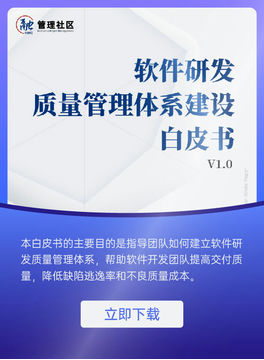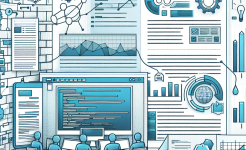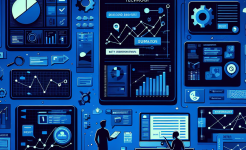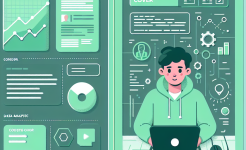本地数据库为什么sa登录不进去
Zentao
Zentao Project Management Software
Title: The Impact of Artificial Intelligence on the Future of Work
Introduction:
Artificial Intelligence (AI) has emerged as a disruptive force, revolutionizing various industries and transforming the way we live and work. This article explores the profound impact of AI on the future of work, delving into its benefits, challenges, and potential solutions. By addressing targeted questions and providing concise answers, this article aims to equip readers with a comprehensive understanding of the subject.
1. Understanding Artificial Intelligence:
1.1 What is Artificial Intelligence?
AI refers to the simulation of human intelligence in machines that are programmed to think, learn, and problem-solve like humans.
1.2 How does AI work?
AI systems rely on algorithms and large datasets to process information, identify patterns, and make decisions without explicit human intervention.
2. The Benefits of AI in the Workplace:
2.1 Enhanced Efficiency:
AI can automate repetitive tasks, freeing up human employees to focus on more complex and creative work.
2.2 Improved Decision-Making:
AI algorithms can analyze vast amounts of data quickly, enabling organizations to make data-driven decisions with greater accuracy.
2.3 Increased Productivity:
By augmenting human capabilities, AI can optimize workflows, streamline processes, and boost overall productivity.
2.4 Enhanced Safety:
AI-powered robots and machines can perform hazardous tasks, reducing the risk of workplace accidents and injuries.
3. The Challenges of AI in the Workplace:
3.1 Job Displacement:
AI has the potential to automate certain jobs, leading to concerns about widespread job losses and unemployment.
3.2 Skills Gap:
As AI evolves, the demand for new skillsets will arise, creating a mismatch between the skills possessed by the workforce and those required for AI-related roles.
3.3 Ethical Considerations:
The use of AI raises ethical concerns, such as privacy, bias, transparency, and accountability. Ensuring responsible and ethical AI implementation is crucial.
3.4 Adaptability and Reskilling:
To mitigate the impact of job displacement, individuals and organizations must embrace continuous learning, reskilling, and adaptability.
4. The Future of Work with AI:
4.1 Job Augmentation:
Rather than replacing humans, AI is expected to augment human capabilities, creating new roles and opportunities.
4.2 Emphasizing Human Skills:
As AI handles routine tasks, the importance of uniquely human skills such as critical thinking, creativity, emotional intelligence, and problem-solving will increase.
4.3 Collaborative Workforce:
AI will facilitate greater collaboration between humans and machines, enabling them to work together synergistically.
4.4 Upskilling and Lifelong Learning:
To thrive in the AI-driven future, individuals need to continually upskill and engage in lifelong learning to remain relevant and adaptable.
5. Solutions for a Smooth Transition:
5.1 Education and Training:
Investing in education and training programs that focus on AI-related skills will help individuals and organizations adapt to the changing landscape.
5.2 Ethical Guidelines and Regulations:
Governments and organizations must develop and implement ethical frameworks and regulations to ensure responsible AI development and deployment.
5.3 Collaboration and Knowledge Sharing:
Encouraging collaboration between academia, industry, and policymakers will foster innovation, knowledge sharing, and effective AI implementation.
5.4 Social Safety Nets:
Governments and organizations should establish safety nets, such as universal basic income and job transition assistance, to support workers affected by AI-driven changes.
Summary:
Artificial Intelligence is poised to transform the future of work, offering immense potential for increased efficiency, improved decision-making, and enhanced safety. However, challenges such as job displacement, skills gaps, and ethical considerations must be addressed. The future of work with AI will emphasize the augmentation of human capabilities, collaboration between humans and machines, and the necessity of lifelong learning. By investing in education, developing ethical guidelines, fostering collaboration, and implementing social safety nets, we can ensure a smooth transition into an AI-powered future.
POPULAR TAGS
Project management system(114)Construction project management(94)What is the IPD development process(76)IT project management(57)Project management experience(56)Project cost management(54)Software project management(53)What is project management(52)IPD management system(50)IPD process management(49)Senior project manager(49)IPD project schedule management(48)Project management engineer(47)IPD project life cycle management(47)Investment project management(46)Five steps of IPD project management(44)IPD R(43)amp;D process(43)Project manager(43)IPD project management software(42)Project quality management(42)Project risk management(42)IPD process guide(41)amp;D project management(39)R(39)IPD project management process(38)IPD development process(37)IPD process tr(37)IPD project consulting(36)IPD Project Management(36)











